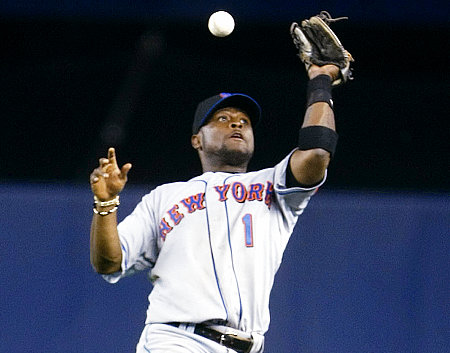
This offseason, we’re looking at the Mets’ history with free agency. Leading off the list of forgettable signings were Roger Cedeño, Jeurys Familia, and James McCann. Next is a second baseman who starred for another NL East club, came to New York in a trade, but regressed once he was re-signed.
Luis Castillo‘s career as a Met is defined by a single play. Misplay would be more accurate. If you’re reading this, you probably know it.
Unlike how some feel about Carlos Beltrán, it really did epitomize his time in New York. The three-time All-Star and two-time stolen base champ in Florida used a two-month stint to get a big contract which quickly had its drawbacks.
The Mets became pretty familiar with what Castillo could add to a team. Paired with Juan Pierre, he was a key contributor at the top of a Florida Marlins lineup that captured the World Series title in 2003. Castillo’s primary asset was his speed. He stole 50 bases in 1999, 62 the next year, and 48 more in 2002.
Castillo also played elite defense. In that championship year of ’03, Castillo won the first of three straight Gold Glove awards at second base. From 2000 through 2005, he compiled a 19.9 bWAR.
Castillo was picked up by the Minnesota Twins in 2006, and while he batted better than .300 for more than a year, he wasn’t the same stolen base threat he was in Florida. His on-base percentage also took a slight decline. Nevertheless, the Mets went after him at the trade deadline in 2007.
On July 30, Castillo came to Queens in exchange for two minor leaguers. After the deal, he reached base safely in 40 of his final 46 games, scoring 34 runs and batting .296. That off-season, the Mets decided to turn the two-month rental into a long-term commitment. At age 32, the Mets rewarded Castillo with a four-year $24 million contract.
The rest of Castillo’s time with the Mets was plagued by injuries, underwhelming play, and dissatisfaction from fans and himself. Two of his most redeeming qualities soon dissipated — he would no longer be a stolen base threat and he was no longer a Gold Glove-caliber fielder.
Castillo’s physical health, which started to worsen in 2008, was arguably the biggest reason. Castillo couldn’t stay on the field both because he was hurt and he couldn’t hit when he was presumably healthy. His splits nosedived to .245/.355/.305 over 87 games and stole 17 bases.
The Mets failed to make the postseason for the second straight year in 2008 and fans began to sour on certain players, with Castillo being one of the main targets. It only got worse in 2009 — June 12 specifically. It’s the date everyone remembers, and Castillo would certainly like to forget. His drop on a fly ball that turned a Mets victory into a Yankees walk-off created one of the worst regular seasons losses in team history and was a focal point in a disastrous year all around.
As far as the fans were concerned, Castillo couldn’t live it down. Not even a .302 batting average with a .387 on-base percentage and 77 runs scored over 142 games in spite of more injuries would do it.
If Castillo didn’t feel the hex after that nightmarish occasion, he certainly did on August 4. That was the day the Citi Field dugout steps had it out for him. After an at-bat in which he was retired, Castillo fell coming back to the bench and sprained his ankle. It was another clear sign that wearing a Mets uniform was like walking under a ladder for the former All-Star.
Despite his above-average offensive season in 2009, all Castillo got for his troubles was boos during introductions on Opening Day 2010. Issues with both feet caused him to miss significant time in what became a dreadful year — one in which his OPS+ fell to 68 and he stole only eight bases. That summer, Castillo questioned why he was sitting on the bench despite his numbers.
“I can’t be here anymore,” he said, with another year on his contract. “I know I’m not going to be here next year.”
He was right. In Spring Training 2011, the Mets released him and took responsibility for the balance of the $6 million left on the deal. Luis Castillo was an example of wrong place at the wrong time — both for himself and for the team.















